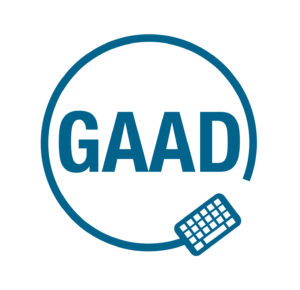
Global Accessibility Awareness Day (GAAD) will be on May 21st, 2020. According to the GAAD website, “The target audience of GAAD is the design, development, usability, and related communities who build, shape, fund and influence technology and its use. While people may be interested in the topic of making technology accessible and usable by persons with disabilities, the reality is that they often do not know how or where to start. Awareness comes first.”
What better way to celebrate than to move accessibility forward in your organization. There is no limit to the ways you can do so, but here are 20 ideas.
Learn About Digital Access
1. Learn how to make your social media campaign accessible.
The Social Media Accessibility Toolkit will give you the tools you need to make sure your social media is accessible to your fans and followers.
2. Learn to create accessible documents and PowerPoint presentations.
The Creating Accessible Documents Toolkit will provide you with the basic techniques for making sure documents and presentations are accessible.
3. Share resources on digital access with all those who have a part in creating websites for your organization.
This is a great video to share. Introduction to Web Accessibility and W3C Standards (YouTube) explains the basics of ensuring websites are accessible.
4. Attend one of our webinars on digital access.
Watch the schedule of upcoming webinars on topics such as social media accessibility, document accessibility and more. Webinars are free but registration is required.
Learn About the Disability Rights Movement
5. Watch Crip Camp on Netflix and schedule a virtual discussion about it with your staff.
Crip Camp explores the universal experience of summer camp awakenings that would transform lives and shape the future of the disability rights movement.
6. Host a virtual book club and read Judy Heumann’s newly released book, Being Heumann: An Unrepentant Memoir of a Disability Rights Activist
Judy Heumann is an international disability rights activists who played a central role in the 504 Sit-in, leading to the signing of the 504 regulations. In her memoir, she shares her experiences “fighting for the right to receive an education, have a job, and just be human.”
Challenge Your Organization’s Perception of Disability
7. Host a virtual lunch and learn using one of these excellent TedTalks and follow it up with a discussion.
The talks by Stella Young (I’m not your inspiration, thank you very much) and Maysoon Zayid (I have 99 problems…and palsy is only one) are great ones to start with.
8. Host a virtual art display featuring a local disabled artist and activist from your area.
You could even use a Facebook page to do this. Just make sure to learn how to make those images accessible first.
9. Host a photography contest and feature the photos on your Facebook page.
Invite people with disabilities to take photos that show the barriers they typically face in your community or that challenge typical perceptions of disability. Again, make sure the photos are shared in an accessible way.
Communicate Your Commitment to Access
10. Add a statement to your website that communicates your organization’s commitment to creating an accessible website.
Example: We are committed to creating an accessible website. If you encounter any barriers that result from the design of this site, please do not hesitate to contact us at [email].
11. Provide a method for reporting access barriers.
Post a form online that allows employees and customers to report barriers. Make sure to have a plan for responding to these concerns and removing the barriers.
Assess Your Organization’s Accessibility
12. Use a free online tool to check your website for accessibility.
You can check your website’s accessibility using WAVE. It won’t identify all of the accessibility issues but will give you a sense of how you are doing. For a more extensive accessibility review of your website, don’t hesitate to contact us. You can email Melanie Thornton at mthornt@uark.edu.
13. See how you measure up with other businesses with the Disability Equality Index.
The Disability Equality Index is a benchmarking tool that offers businesses an opportunity to receive a score on their disability inclusion policies and practices.
14. Perform a TechCheck to assess your organization’s technology accessibility practices.
Partnership on Employment and Accessible Technology (PEAT) TechCheck can help give you a benchmarking “snapshot” of the current state of your technology in terms of accessibility.
15. Ask employees with disabilities what they think.
Get input from employees with disabilities about how your organization is doing in its efforts to create an accessible and inclusive environment.
16. Check your hiring process and accommodation process for employees for usability.
Is your online application process accessible? Is the information for employees to request accommodation easy to find? These are good places to start making changes to be more inclusive to disabled employees.
Raise Awareness About Inclusion and Access
17. Plan for your return to your office by ordering posters that promote access and inclusion.
Choose posters that are most fitting for your organizations from one of these pages:
- UA Partners, Explore Access: Posters and Meme Page
- National Center for College Students with Disabilities Posters (specifically for colleges)
18. Create a social media campaign that promotes access and inclusion and disability as an aspect of diversity.
Here are a few options
- Social Media – Did You Know?: A series of quick tips and facts about digital accessibility. Each fact or tip has a meme associated with it.
- UA Partners, Explore Access: Posters and Meme Page
- Follow us on Facebook and Twitter and re-share what we post.
- Follow the hashtag #GAAD and re-post or retweet.
19. Make a plan for increasing the accessibility of your website.
Look at the results from your automated testing and determine the first area you’d like to focus on to improve your website.
